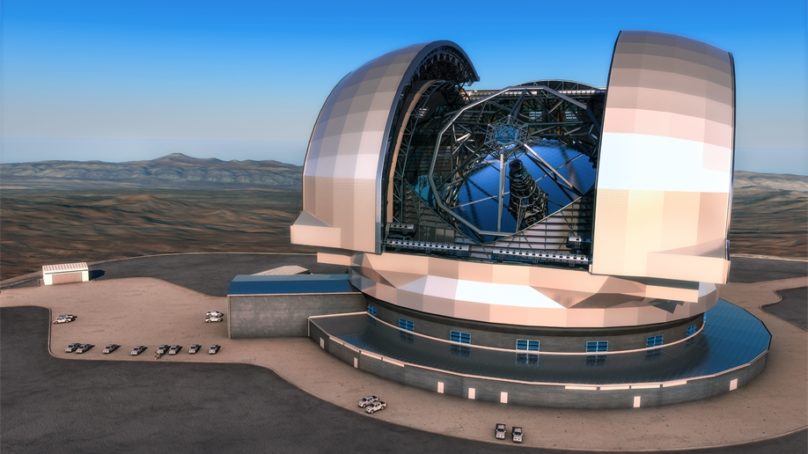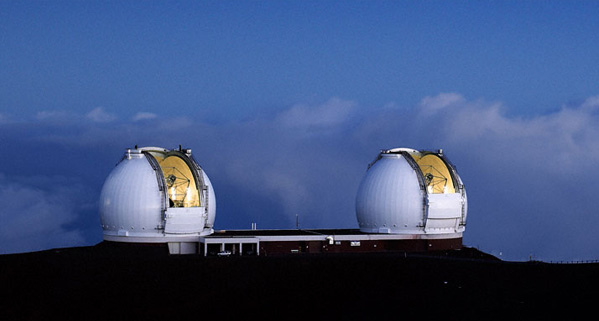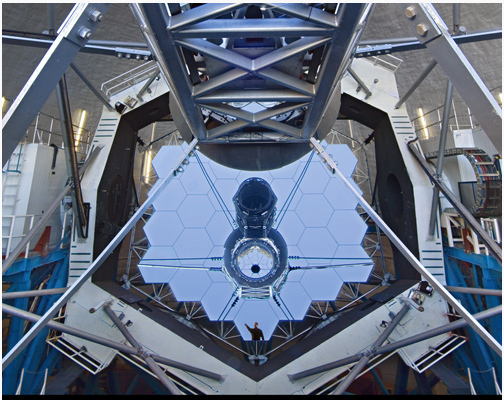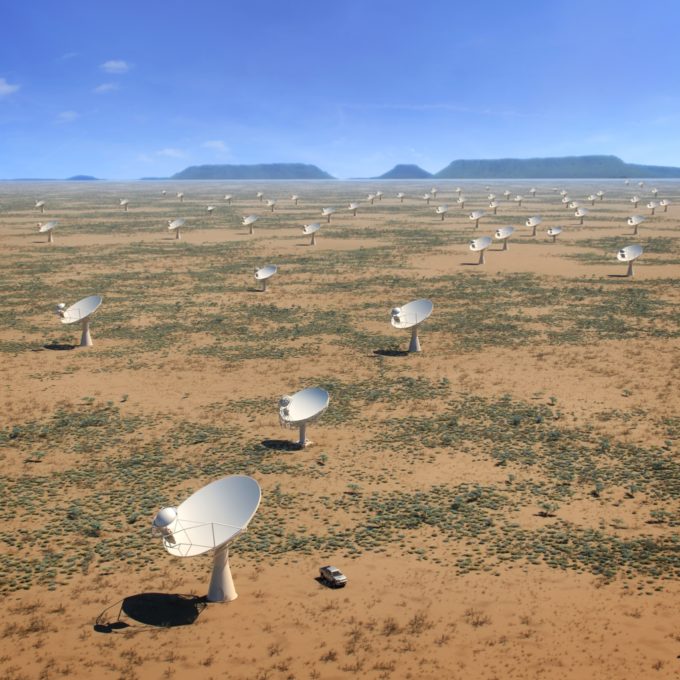
Astronomy has reached a fascinating point. Several new, extremely advanced telescopes will come online in the next few years that are likely to change forever our view of the cosmos. These instruments will be so powerful that they will completely overshadow today’s telescopes. With them we will be able to see further back in time to the Big Bang than ever before, and scrutinize the atmospheres of exoplanets for evidence of extra-terrestrial life. In this article I will outline how the key scientific questions and technologies have shaped the coming new generation of space and ground-based telescopes.
The last 400 years have seen the telescope develop from the simple spyglass, a pair of lenses mounted in sliding tubes, to highly sophisticated 10-metre instruments, capable of tracing the orbits of hapless stars caught in the thrall of the supermassive black hole lurking at the heart of the Milky Way. As the pace of astronomical discovery quickened during the 20th century, each question answered has raised new ones. The key questions in astronomy today are: what is dark matter; what is dark energy; how did the first galaxies form; and, are there habitable, Earth-like exoplanets? This includes the search for biomarkers – signs of the molecules of prebiotic life.
Many of the biggest challenges faced by the next telescopes come from the need to detect the faint light from enormously distant galaxies. These are young objects, formed less than one billion years after the Big Bang, and studying them is critical to understanding galaxy formation and evolution. Their light has not only been strongly redshifted by the cosmic expansion (draining away the energy of the photons), but the inverse square law has also diluted its intensity. A candle seen twenty feet away is only a quarter as bright as one ten feet away.
Bigger is Better
In 1928, George Ellery Hale, the astronomer, entrepreneur and builder of several world-leading telescopes wrote: “Starlight is falling on every square mile of the Earth’s surface, and the best we can do at present is to gather up and concentrate the rays that strike an area 100 inches in diameter”. While the numbers have changed, the message remains. Hale was right to recognise that one of the most important parameters of a telescope is its aperture, D. The captured flux of photons is proportional to the aperture area, D2. The two 10-metre Keck telescopes (Fig. 1), although built in 1992, embody many design features found in the next telescopes. Each collects five million times as much light as the human eye, a figure that will increase by over a factor of ten in the next telescopes.

Fig. 1. : The twin Keck Telescopes located 4,200 m on Mauna Kea in Hawaii.
The second important parameter of a telescope is angular resolution, a measure of the smallest angle it can discern. For a space telescope the resolution is ultimately limited by the diffraction of light to λ/D where λ is the wavelength of the light. This relation suggests that the resolution can be made arbitrarily small if the aperture is large enough. However, Earth-bound telescopes suffer from the blurring effects of atmospheric turbulence, which distorts the incoming wavefronts. The aperture need be no bigger than eight inches if all that is required of it is resolution.
To correct for the atmospheric blurring, large telescopes use Adaptive Optics (AO) systems, firing lasers tuned to the frequencies of sodium atoms. These create artificial stars high above the atmosphere, providing the information needed to sharpen the image. AO systems, originally developed for the military in the 1970s, now enable telescopes to attain diffraction-limited resolution.
There have been huge improvements in detectors. Modern imaging detectors are based on Charged-Coupled Devices (CCDs), arranged as mosaics covering the image plane of a telescope. CCDs convert virtually every photon striking the micron-sized pixels into photoelectrons that are stored and read out into memory. One of the largest CCD cameras (the size of a car) will be in the 8.4-metre Large Synoptic Survey Telescope (LSST), currently under construction in Chile and due to start operation in 2019. This state-of-the-art camera has a total of 189 CCD (4k x 4k pixel) imaging sensors (3.2 Gigapixel) and will be cooled to −100°C, to reduce thermal noise.
Noise, the enemy of weak signals, comes from several sources. The most important of these are: thermal noise in the detectors (hence the cooling), extraneous radiation from the mirror and body of the telescope (particularly important at infrared wavelengths), and the sky background. To detect a weak source, we need to collect as many photons as possible and concentrate them into a pixel. The flux of photons collected by a telescope is proportional to D2, and, for a diffraction-limited telescope, the diameter of the image of a point source is proportional to λ/D. The area of the image spot therefore varies as 1/D2, and so the photon flux on it increases as the fourth power, D4, of the aperture. Size really does matter.
This steep dependence underlines the importance of both large aperture and high resolution, a combination that is borne out by the phenomenal success of the Hubble Space Telescope (HST). Orbiting 600 km above the Earth in the most perfect vacuum of space, the HST’s 2.4-meter mirror achieves its diffraction-limited resolution (0.05 arc seconds, or 14 millionths of a degree).
Extremely Large Telescopes
In 2005 the European Southern Observatory (ESO) conceived a design for a 100-metre telescope – the OWL – or Overwhelmingly Large Telescope. Because it is not possible to fabricate a monolithic mirror of this great size, the plan was to divide the mirror up into many hexagonal segments, each being a part of a much bigger paraboloidal surface.

Fig. 2: Bird’s eye view of the Keck II telescope primary mirror, showing the hexagonal segments and a man’s reflection, for scale.
The segments would be finely positioned using actuators and computer control. It turned out that the OWL was shelved, for complexity and budgetary reasons. But the segmented mirror concept had already been proven on several highly productive telescopes, like the Keck telescopes (Fig. 2). This technology is the favoured way to make Extremely Large Telescopes (ELTs).

Fig. 3: Artist’s impression of the European Extremely Large Telescope (E-ELT). Note the relative size of cars.
Three ELTs are planned to come online in the next decade. The largest of these, the ESO’s European Extremely Large Telescope (E-ELT, Fig. 3), is a scaled-down version of OWL, with a 39-metre segmented mirror. It will be built on Cerro Armazones in Chile at an altitude 3060 metres. The E-ELT is expected to achieve a resolution of 0.01 arc seconds at a wavelength of 2 mm. There will be two sideways-pointing foci, with spectrometers and cameras borne on platforms the size of tennis courts placed astride the telescope. The field of view will be one third of the width of the full moon, and the whole moveable altazimuth structure will weigh 3,000 tons.
Another segmented mirror ELT is the Thirty-Metre Telescope (TMT), which will be sited either on Mauna Kea, or La Palma in the Canary Islands. A different technology will be used in the Giant Magellan Telescope (GMT), which will collect the light from seven 8.2-metre honeycomb mirrors and focus it onto a common focal plane (equivalent to one 22-metre telescope).
To make a honeycomb mirror, glass is melted in a huge rotating furnace. Isaac Newton realised that the surface of a spinning bucket of water naturally assumes a paraboloidal shape. This is what happens in the honeycomb mirror, except that when the glass is cooled the dish shape is frozen in. The rear surface of the mirror has honeycomb-shaped indentations both to reduce both the weight (without sacrificing strength), and the thermalization time.
Making Movies of the Cosmos
While the ELTs will extract a great deal of information from small sky targets, there is a complementary role for survey telescopes with wider fields of view. The Large Synoptic Survey Telescope has a novel three-mirror design giving a field of view of 3.5°, equivalent to 50 full moons.
The LSST will survey the same huge tranche (10,000 square degrees) of the southern sky every three days, in effect enabling it to make ‘movies’ of 10 billion stars and galaxies. The telescope will discover many transient objects, for example: supernovae, near-Earth objects, and variable stars. Objects that change position or brightness will trigger alerts for other telescopes to follow up in more detail within minutes.
In 1915 Einstein showed how space is curved by mass, and how curved space bends light. When the rays of light from distant background galaxies graze past concentrations of mass, for example clusters of galaxies or regions containing dark matter, the light is bent. This bending distorts the optical images of the background galaxies, an effect called gravitational lensing. The LSST will gather lensed data that will reveal dark matter distributions. The high sensitivity of the LSST will enable it to see so far back in time that it will be able to determine the distribution of dark matter as a function of redshift, and so trace its time evolution.
The World’s Largest Scientific Instrument
Imagine a telescope with an aperture of a million square metres, bridging two continents. Science fiction? No, science fact. And it is embodied in the Square Kilometre Array (SKA) radio telescope, which will extend from the Karoo region of South Africa, to the Murchison region of Western Australia. The SKA is expected be completed in the mid-2020s. The sites have been selected on the basis of their sparse populations, since electromagnetic quietness is essential. The SKA will expand the sensitivity, resolution and spectral coverage (50 MHz to 20 GHz) of existing radio telescopes by over ten times, and will transform our view of the Universe.
Radio wavelengths are a million times longer than those of light, so the diffraction-limited resolutions of even large single dishes are limited. The way to make high-resolution observations at radio frequencies was pioneered in the 1960s, by linking up pairs of dishes, as interferometers, to form elements of a much larger simulated antenna (aperture synthesis). Powerful computers are needed to transform the information from such an array of antennas into usable images.
In South Africa, SKA-Mid will consist of a large aperture synthesis array of 250 15-metre paraboloidal radio dishes operating in the range 350 MHz – 15 GHz. There are three groupings. The most compact of these is a five-km dense ‘core’ of antennas, providing half of the collecting area. Outside the core is an intermediate group, reaching distances of 180 km. An outer array, along winding spiral arms, will extend to 3000 km. Think of these outer groupings as representing a ‘zoom’ lens on a camera, and the central core more like a sensitive ‘close-up’ lens. A section of the array is already under construction: this is a smaller pathfinder telescope called MeerKAT (Fig. 4).

Fig. 4: Aerial view of the SKA and MeerKAT dishes in South Africa. Courtesy of the SKA Organisation.
In Australia, the SKA-survey telescope will use similar dishes as SKA-Mid, and these will be equipped with Phased-Array Feeds (PAFs). In a PAF, the focal plane of one dish is populated with an array of detectors, connected to a central site. The elements will form a phased array, creating a pattern of radio beams, viewing different parts of the sky, and speeding up sky surveys. In the Australian Square Kilometre Array Pathfinder (ASKAP) radio telescope, the PAF concept is currently being tested as part of an array of 36 12-metre dishes at frequencies 0.7 GHz – 1.8 GHz, and covering a 30 square degree area of sky.
Also in Australia will be a ‘software telescope’. SKA-low is a low frequency (50 – 350 MHz) aperture array, with 250,000 separate simple low-cost antennas, each able to see the whole sky and having no moving parts. Each antenna is connected to a central correlator with enough fiber-optic cable to girdle the Earth twice. The array will be phased using software to form steerable beams. Like SKA-Mid, most of the antenna elements are densely packed in the central 2 km of the array, and there are also others 50 km away on spiral arms, providing the fine scale information.
The SKA will be well positioned to address the key astronomy questions, and it will also open up new fields. For example, it will probe the cosmic dawn of the Universe, over 13 billion years ago, by observing 21-centimetre radio waves from primordial neutral hydrogen clouds, redshifted to a wavelength of a few metres. The Cradle of Life project will utilise spectroscopy to search for prebiotic molecules, the building blocks of life, such as amino acids. The SKA could detect possible extra-terrestrial signals; its antennas will be sensitive enough to detect an airport radar on a planet 50 light years away. Within this distance there are over 100 stars similar to the Sun, many of which may possess Earth-sized planets.
The sensitivity of the SKA also makes it well suited to finding faint transient sources – such as pulsars in galaxies. The number of known pulsars is around 2,000, a figure that is likely to increase ten times with the SKA. Precise timing measurements of pulses from a large ensemble of pulsars should reveal any spacetime distortions arising from gravitational waves. This will complement measurements of gravitational waves from merging black holes, first observed by the Laser Interferometer Gravitational-Wave Observatory (LIGO) in 2015.
Into Space
The next decade will see the launch of new space telescopes. The Wide-Field Infrared Survey Telescope (WFIRST) satellite is planned for the mid-2020s. It will, like Hubble, use a 2.4-metre mirror but will survey a region 100 times larger at wavelengths of 0.6 – 2 mm. The observatory will survey galaxies, clusters of galaxies, and infer the distribution of dark matter. When a star passes directly in front of another star, the light of the latter is brightened slightly – an effect called gravitational microlensing. If the foreground star also has a planetary system, it is possible to obtain information on the exoplanets, a role to which WFIRST will be well suited.
The European Space Agency’s Euclid 1.2-metre optical/near-infrared space telescope is due for launch in 2020, and will measure a billion galaxies. These data will used to make the most detailed map ever of the 3D distribution of galaxies, dark matter, and dark energy for the last 10 billion years of the Universe. Euclid’s primary mission is to understand why the expansion of the Universe is accelerating. The source of this acceleration is a mysterious dark energy, constituting 75% of the matter-energy content of the Universe. If our model of the Universe is correct, Euclid’s 3D map should reveal, imprinted on the distribution of galaxies, the memories of the primordial fluctuations of matter now expanded to immense scales of around 2 billion light years.
The James Webb Space Telescope
The Hubble space telescope has produced many striking images of the cosmos. But some of the most important are its ‘deep fields’. These show that the first galaxies to form looked very different to today’s more mature ones. When galaxies form, they contain new, hot, and massive stars that shine brightly in ultraviolet light. Due to the expansion of the Universe, the ultraviolet light from these galaxies has been redshifted into the far infrared. An infrared telescope is therefore needed to see these galaxies, and this is the role that the next large space telescope will fill.

Fig. 5: The James Webb Space Telescope sitting on its sunshield.
We are now preparing for an Ariane 5 rocket to launch the HST’s successor, the James Webb Space Telescope (JWST, or Webb) in 2018 (Fig. 5). The JWST is a wholly infrared telescope with a huge 6.5-metre mirror. Webb will also carry sensitive cameras and advanced imaging spectrographs for infrared wavelengths.
How do you squeeze a 6.5-metre mirror in the nosecone of a rocket? The gold-coated JWST mirror is made from a mosaic of 18 lightweight hexagonal beryllium segments that are carefully folded like origami. When the telescope arrives at its Lagrangian point, one million miles from the Earth and away from the sun, the segments will unfurl, like a butterfly emerging from a chrysalis, to produce the mirror. The mirror will be cooled so that its own heat does not overwhelm the faint cosmic light. The telescope’s detectors, located in the Integrated Science Instrument Module, will also be cooled and the telescope will have a sunshield, the size of a tennis-court, blocking the heat from the sun, Earth, and moon.
Infrared telescopes can see deeply into the hearts of the dusty clouds that lie in the plane of disc galaxies like the Milky Way. This is because infrared, unlike visible light, is only weakly scattered by dust grains. Webb will therefore be able to probe interstellar star-forming regions, search for protoplanetary discs, and see the emission from organic molecules, delineating star-forming regions, such as the Pillars of Creation with 100 times the resolution of Hubble. The telescope will also look for the direct light from exoplanets and image them using a coronagraph, a disc placed in the focal plane to block the dazzling light from the host star. Webb will search for biomarkers: these are the tell-tale fingerprints of extra-terrestrial life that include oxygen, carbon dioxide and water vapour molecules in the atmospheres of exoplanets.
In summary, the next telescopes will strain at the limits of what is technically possible, and target the key questions: what is the nature of dark matter; what is dark energy; how did the first galaxies form; and are there habitable Earth-like exoplanets? The last question is a tremendously exciting one because it includes the search for biomarkers. Will the next telescopes tell us that we are not alone in the Universe?
About the Author
I began my science career as an astronomer, using the radio telescopes at Cambridge University’s Mullard Radio Astronomy Observatory, to observe colliding galaxies. After a period working on fundamental low temperature condensed matter physics (investigating the contact electrification of solidified noble gases) at UMIST, Manchester, I then branched out into plasma physics (not far from astrophysics), moving to the Culham Centre For Fusion Energy and the Joint European Torus (JET) project, working on magnetically confined plasmas. JET is a toroidal magnetic chamber (tokamak) experiment, in which the confined plasma is heated by powerful neutral beams and radio frequency waves to temperatures hotter than the centre of the Sun, of 100 million degrees. In these experiments, I identified super-thermal radio emission from energetic fusion-produced alpha-particles. I was Director of the Culham International Summer School for Plasma Physics from 2006-2011. I am a Fellow of the Royal Astronomical Society, and visiting scientist at Rutherford Appleton laboratories, and at the Oxford University Astrophysics Department. I currently live in Oxford, where I enjoy making (and writing) music, tackling the challenges in writing about science, and running an observatory in my garden. To learn more or to contact me, please visit my website, www.science.geoffcottrell.com


